A major exhibition at the Metropolitan Museum of Art in New York is shedding light on Ancient Egypt’s main deities. “Divine Egypt” explores the role of gods and goddesses in ancient Egyptian culture, delving into how they were experienced in temples, shrines, and tombs, and how people connected with them in daily worship. The exhibit examines the vital link between the human and divine worlds, highlighting the significance of gods like Anubis, Horus, and Isis in ancient Egyptian society.
Over 3,000 years, ancient Egyptians developed a polytheistic culture centered around a plethora of gods and goddesses, with approximately 1,500 deities worshipped. The exhibition focuses on 25 of the main deities, bringing together over 200 works of art, including small figurines and monumental limestone statues. The show covers all periods of ancient Egyptian history, with 140 pieces from the Met’s own collection and others lent by museums worldwide.
This exhibition, the first major Egyptian show at the museum in over a decade, explores the relationship between royal and ordinary people and the gods. According to Diana Craig Patch, Ancient Egypt art curator at the museum, the exhibit aims to demonstrate how ancient Egyptians related to their world through these images. The gods played a crucial role in helping people navigate problems of life, death, and meaning, which are still relevant today.
The sun god Ra is a prominent feature of the exhibition, with a dedicated gallery showcasing his morning aspect as a giant scarab beetle. Ra was seen as the source of light and warmth, ruling the world. Another notable exhibit is the imposing statue of Horus, the falcon god, who was always depicted with a double crown, signifying his role as king of Egypt.
The exhibition runs until January 19, 2026, offering a unique opportunity for visitors to explore the divine landscape of ancient Egypt. By examining the role of gods and goddesses in ancient Egyptian culture, “Divine Egypt” provides a fascinating glimpse into the daily lives and beliefs of ancient Egyptians, highlighting the enduring significance of their spiritual practices and traditions.
